Organisational Behaviour Report
VerifiedAdded on 2020/10/05
|15
|4322
|238
Report
AI Summary
This report delves into the intricacies of organisational behaviour, focusing on the influence of culture, politics, and power on team dynamics within Tesco. It covers various motivational theories, the characteristics of effective teams, and the philosophies guiding organisational behaviour. The report concludes with recommendations for enhancing productivity and achieving organisational goals.
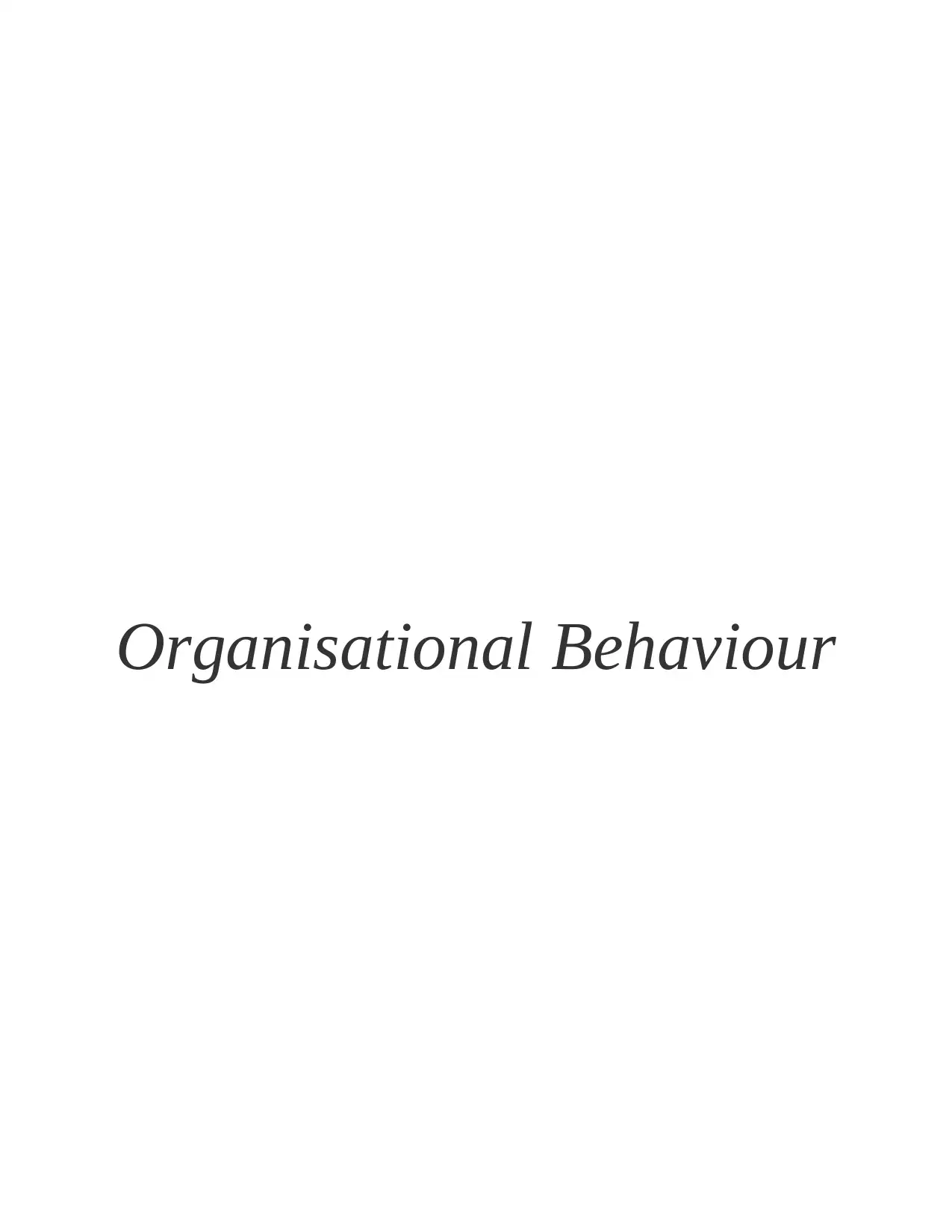
Organisational Behaviour
Paraphrase This Document
Need a fresh take? Get an instant paraphrase of this document with our AI Paraphraser
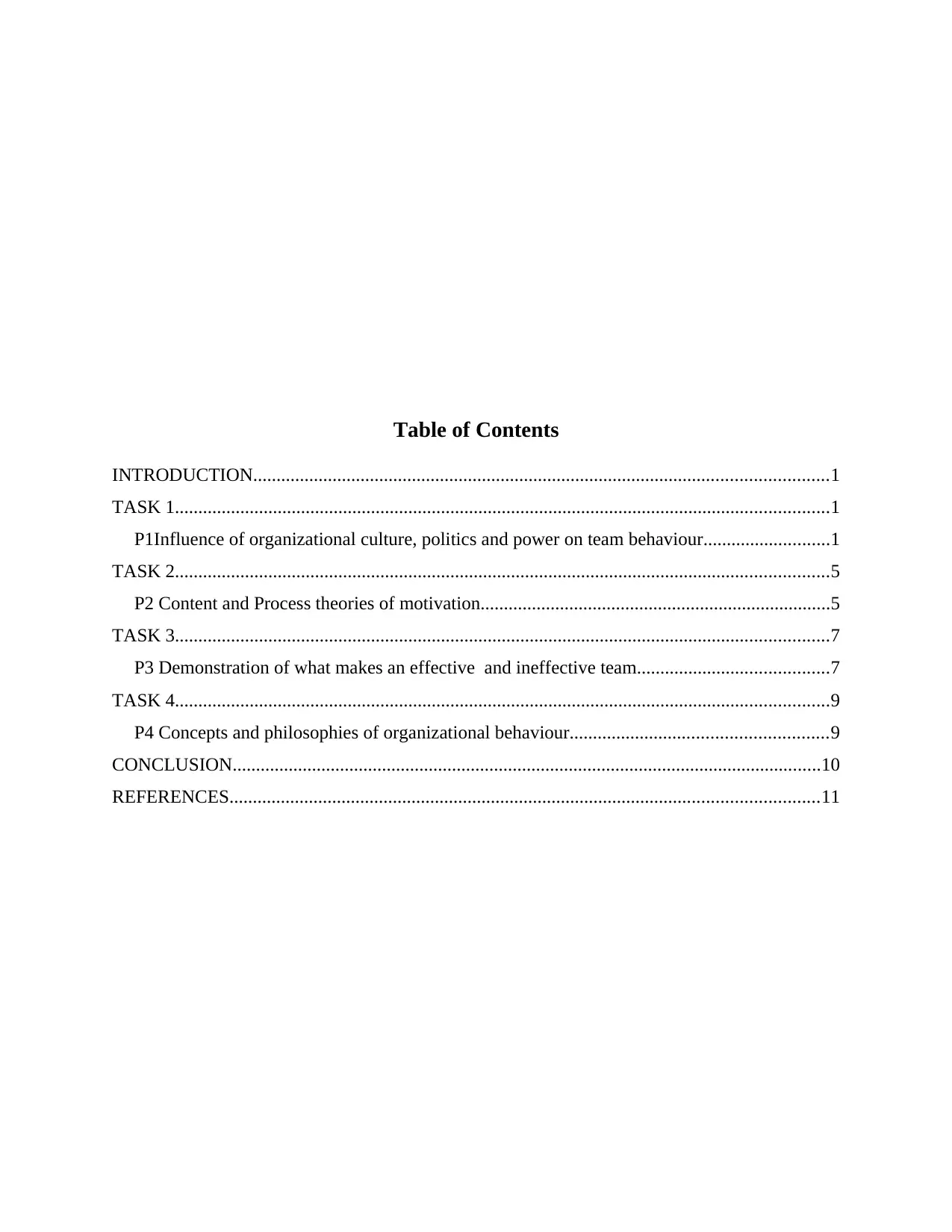
Table of Contents
INTRODUCTION...........................................................................................................................1
TASK 1............................................................................................................................................1
P1Influence of organizational culture, politics and power on team behaviour...........................1
TASK 2............................................................................................................................................5
P2 Content and Process theories of motivation...........................................................................5
TASK 3............................................................................................................................................7
P3 Demonstration of what makes an effective and ineffective team.........................................7
TASK 4............................................................................................................................................9
P4 Concepts and philosophies of organizational behaviour.......................................................9
CONCLUSION..............................................................................................................................10
REFERENCES..............................................................................................................................11
INTRODUCTION...........................................................................................................................1
TASK 1............................................................................................................................................1
P1Influence of organizational culture, politics and power on team behaviour...........................1
TASK 2............................................................................................................................................5
P2 Content and Process theories of motivation...........................................................................5
TASK 3............................................................................................................................................7
P3 Demonstration of what makes an effective and ineffective team.........................................7
TASK 4............................................................................................................................................9
P4 Concepts and philosophies of organizational behaviour.......................................................9
CONCLUSION..............................................................................................................................10
REFERENCES..............................................................................................................................11
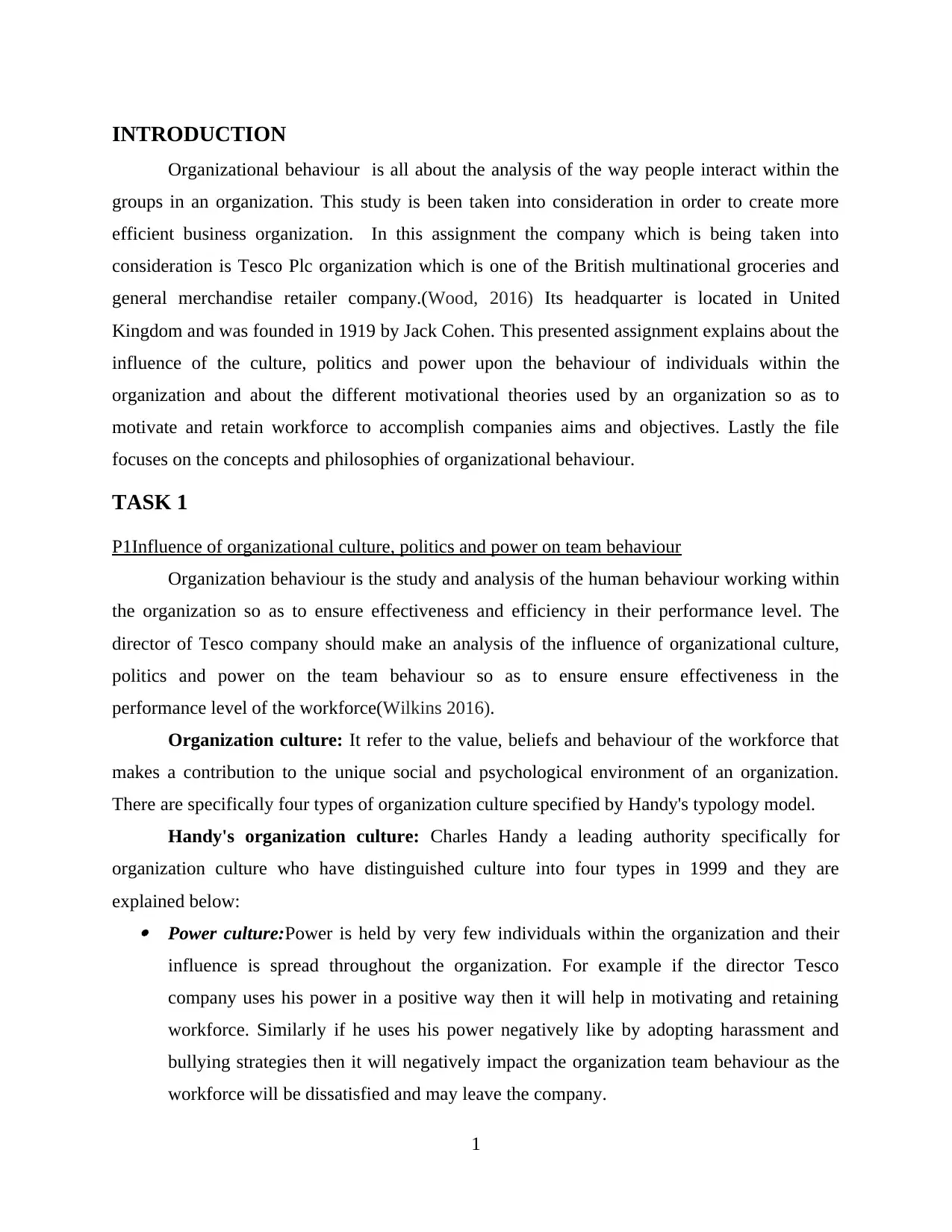
INTRODUCTION
Organizational behaviour is all about the analysis of the way people interact within the
groups in an organization. This study is been taken into consideration in order to create more
efficient business organization. In this assignment the company which is being taken into
consideration is Tesco Plc organization which is one of the British multinational groceries and
general merchandise retailer company.(Wood, 2016) Its headquarter is located in United
Kingdom and was founded in 1919 by Jack Cohen. This presented assignment explains about the
influence of the culture, politics and power upon the behaviour of individuals within the
organization and about the different motivational theories used by an organization so as to
motivate and retain workforce to accomplish companies aims and objectives. Lastly the file
focuses on the concepts and philosophies of organizational behaviour.
TASK 1
P1Influence of organizational culture, politics and power on team behaviour
Organization behaviour is the study and analysis of the human behaviour working within
the organization so as to ensure effectiveness and efficiency in their performance level. The
director of Tesco company should make an analysis of the influence of organizational culture,
politics and power on the team behaviour so as to ensure ensure effectiveness in the
performance level of the workforce(Wilkins 2016).
Organization culture: It refer to the value, beliefs and behaviour of the workforce that
makes a contribution to the unique social and psychological environment of an organization.
There are specifically four types of organization culture specified by Handy's typology model.
Handy's organization culture: Charles Handy a leading authority specifically for
organization culture who have distinguished culture into four types in 1999 and they are
explained below: Power culture:Power is held by very few individuals within the organization and their
influence is spread throughout the organization. For example if the director Tesco
company uses his power in a positive way then it will help in motivating and retaining
workforce. Similarly if he uses his power negatively like by adopting harassment and
bullying strategies then it will negatively impact the organization team behaviour as the
workforce will be dissatisfied and may leave the company.
1
Organizational behaviour is all about the analysis of the way people interact within the
groups in an organization. This study is been taken into consideration in order to create more
efficient business organization. In this assignment the company which is being taken into
consideration is Tesco Plc organization which is one of the British multinational groceries and
general merchandise retailer company.(Wood, 2016) Its headquarter is located in United
Kingdom and was founded in 1919 by Jack Cohen. This presented assignment explains about the
influence of the culture, politics and power upon the behaviour of individuals within the
organization and about the different motivational theories used by an organization so as to
motivate and retain workforce to accomplish companies aims and objectives. Lastly the file
focuses on the concepts and philosophies of organizational behaviour.
TASK 1
P1Influence of organizational culture, politics and power on team behaviour
Organization behaviour is the study and analysis of the human behaviour working within
the organization so as to ensure effectiveness and efficiency in their performance level. The
director of Tesco company should make an analysis of the influence of organizational culture,
politics and power on the team behaviour so as to ensure ensure effectiveness in the
performance level of the workforce(Wilkins 2016).
Organization culture: It refer to the value, beliefs and behaviour of the workforce that
makes a contribution to the unique social and psychological environment of an organization.
There are specifically four types of organization culture specified by Handy's typology model.
Handy's organization culture: Charles Handy a leading authority specifically for
organization culture who have distinguished culture into four types in 1999 and they are
explained below: Power culture:Power is held by very few individuals within the organization and their
influence is spread throughout the organization. For example if the director Tesco
company uses his power in a positive way then it will help in motivating and retaining
workforce. Similarly if he uses his power negatively like by adopting harassment and
bullying strategies then it will negatively impact the organization team behaviour as the
workforce will be dissatisfied and may leave the company.
1
⊘ This is a preview!⊘
Do you want full access?
Subscribe today to unlock all pages.

Trusted by 1+ million students worldwide
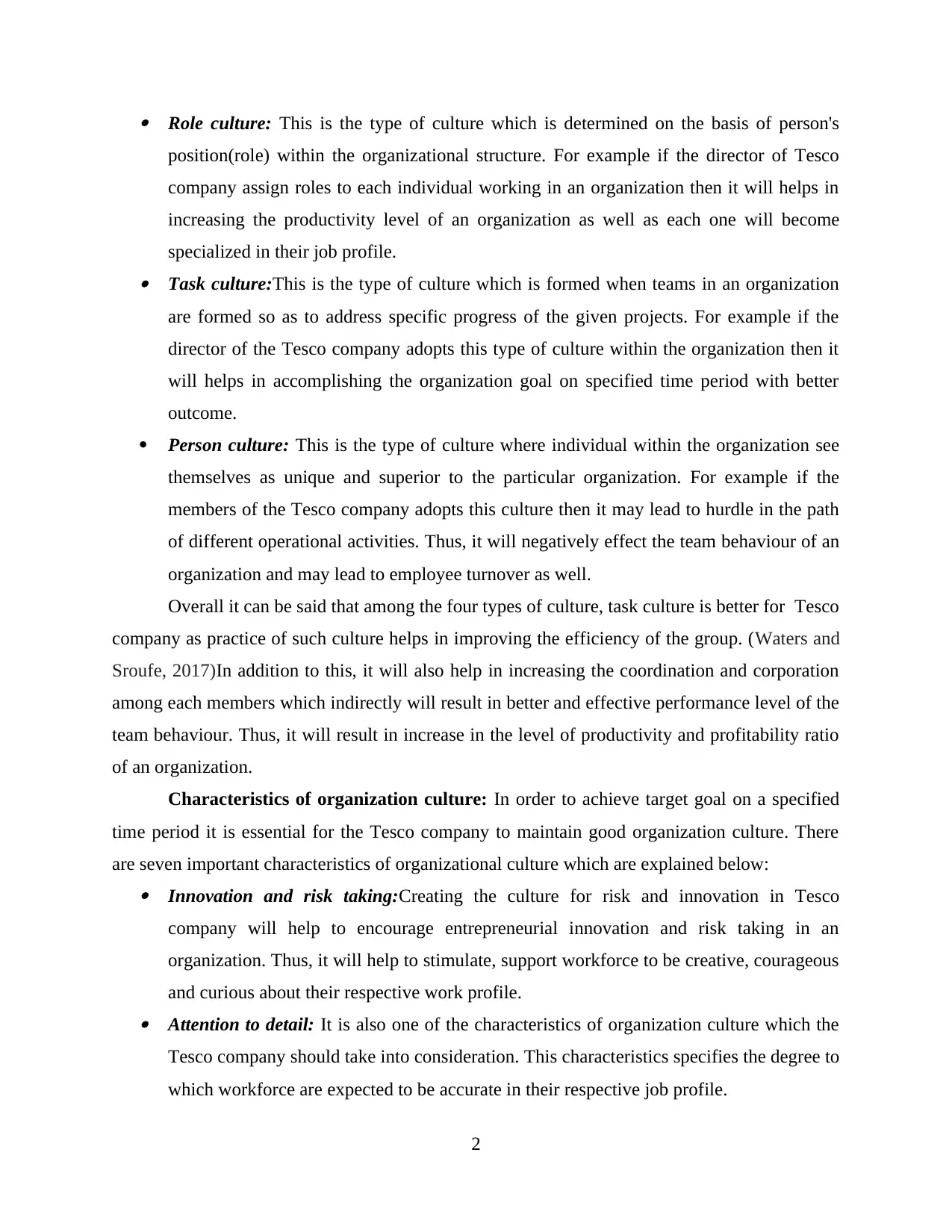
Role culture: This is the type of culture which is determined on the basis of person's
position(role) within the organizational structure. For example if the director of Tesco
company assign roles to each individual working in an organization then it will helps in
increasing the productivity level of an organization as well as each one will become
specialized in their job profile. Task culture:This is the type of culture which is formed when teams in an organization
are formed so as to address specific progress of the given projects. For example if the
director of the Tesco company adopts this type of culture within the organization then it
will helps in accomplishing the organization goal on specified time period with better
outcome.
Person culture: This is the type of culture where individual within the organization see
themselves as unique and superior to the particular organization. For example if the
members of the Tesco company adopts this culture then it may lead to hurdle in the path
of different operational activities. Thus, it will negatively effect the team behaviour of an
organization and may lead to employee turnover as well.
Overall it can be said that among the four types of culture, task culture is better for Tesco
company as practice of such culture helps in improving the efficiency of the group. (Waters and
Sroufe, 2017)In addition to this, it will also help in increasing the coordination and corporation
among each members which indirectly will result in better and effective performance level of the
team behaviour. Thus, it will result in increase in the level of productivity and profitability ratio
of an organization.
Characteristics of organization culture: In order to achieve target goal on a specified
time period it is essential for the Tesco company to maintain good organization culture. There
are seven important characteristics of organizational culture which are explained below: Innovation and risk taking:Creating the culture for risk and innovation in Tesco
company will help to encourage entrepreneurial innovation and risk taking in an
organization. Thus, it will help to stimulate, support workforce to be creative, courageous
and curious about their respective work profile. Attention to detail: It is also one of the characteristics of organization culture which the
Tesco company should take into consideration. This characteristics specifies the degree to
which workforce are expected to be accurate in their respective job profile.
2
position(role) within the organizational structure. For example if the director of Tesco
company assign roles to each individual working in an organization then it will helps in
increasing the productivity level of an organization as well as each one will become
specialized in their job profile. Task culture:This is the type of culture which is formed when teams in an organization
are formed so as to address specific progress of the given projects. For example if the
director of the Tesco company adopts this type of culture within the organization then it
will helps in accomplishing the organization goal on specified time period with better
outcome.
Person culture: This is the type of culture where individual within the organization see
themselves as unique and superior to the particular organization. For example if the
members of the Tesco company adopts this culture then it may lead to hurdle in the path
of different operational activities. Thus, it will negatively effect the team behaviour of an
organization and may lead to employee turnover as well.
Overall it can be said that among the four types of culture, task culture is better for Tesco
company as practice of such culture helps in improving the efficiency of the group. (Waters and
Sroufe, 2017)In addition to this, it will also help in increasing the coordination and corporation
among each members which indirectly will result in better and effective performance level of the
team behaviour. Thus, it will result in increase in the level of productivity and profitability ratio
of an organization.
Characteristics of organization culture: In order to achieve target goal on a specified
time period it is essential for the Tesco company to maintain good organization culture. There
are seven important characteristics of organizational culture which are explained below: Innovation and risk taking:Creating the culture for risk and innovation in Tesco
company will help to encourage entrepreneurial innovation and risk taking in an
organization. Thus, it will help to stimulate, support workforce to be creative, courageous
and curious about their respective work profile. Attention to detail: It is also one of the characteristics of organization culture which the
Tesco company should take into consideration. This characteristics specifies the degree to
which workforce are expected to be accurate in their respective job profile.
2
Paraphrase This Document
Need a fresh take? Get an instant paraphrase of this document with our AI Paraphraser
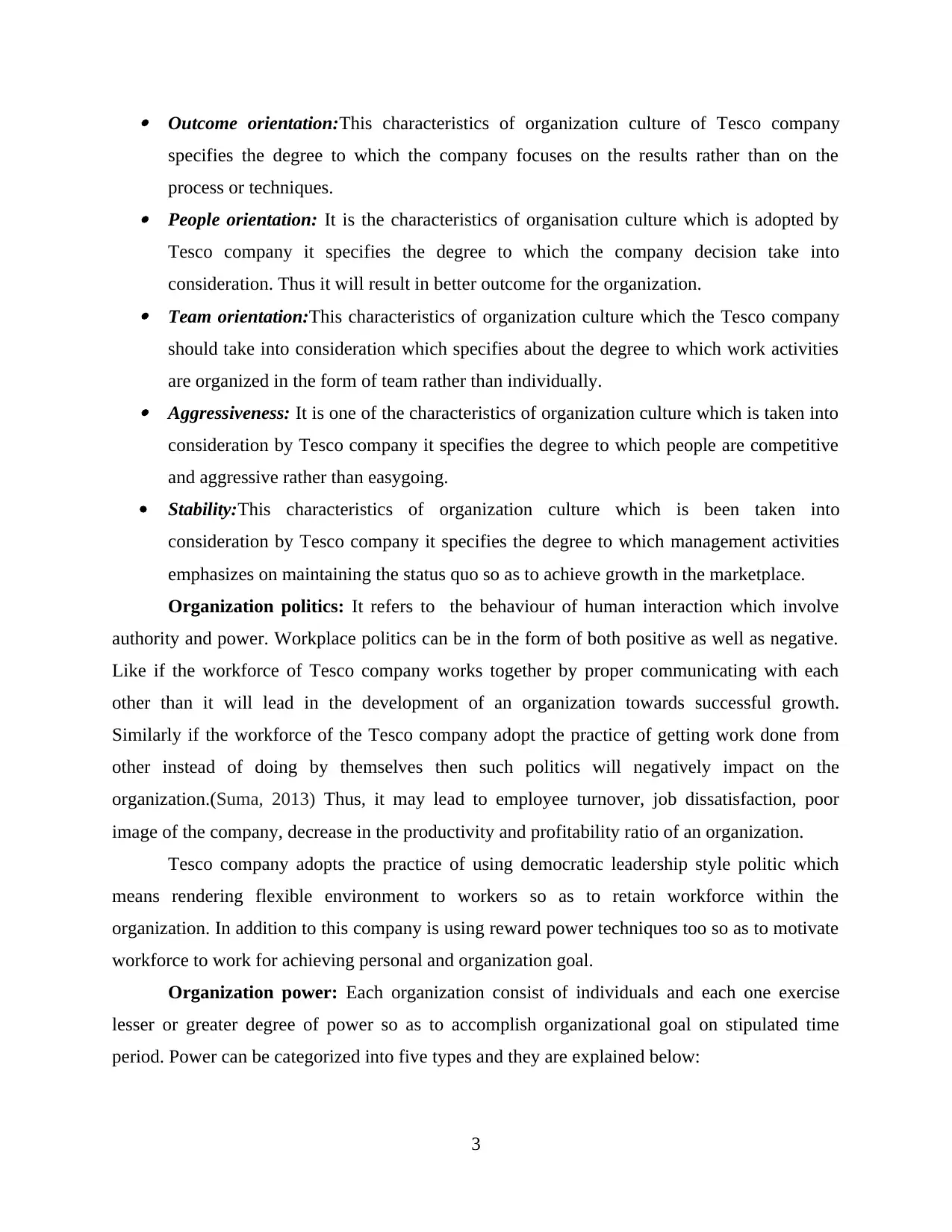
Outcome orientation:This characteristics of organization culture of Tesco company
specifies the degree to which the company focuses on the results rather than on the
process or techniques. People orientation: It is the characteristics of organisation culture which is adopted by
Tesco company it specifies the degree to which the company decision take into
consideration. Thus it will result in better outcome for the organization. Team orientation:This characteristics of organization culture which the Tesco company
should take into consideration which specifies about the degree to which work activities
are organized in the form of team rather than individually. Aggressiveness: It is one of the characteristics of organization culture which is taken into
consideration by Tesco company it specifies the degree to which people are competitive
and aggressive rather than easygoing.
Stability:This characteristics of organization culture which is been taken into
consideration by Tesco company it specifies the degree to which management activities
emphasizes on maintaining the status quo so as to achieve growth in the marketplace.
Organization politics: It refers to the behaviour of human interaction which involve
authority and power. Workplace politics can be in the form of both positive as well as negative.
Like if the workforce of Tesco company works together by proper communicating with each
other than it will lead in the development of an organization towards successful growth.
Similarly if the workforce of the Tesco company adopt the practice of getting work done from
other instead of doing by themselves then such politics will negatively impact on the
organization.(Suma, 2013) Thus, it may lead to employee turnover, job dissatisfaction, poor
image of the company, decrease in the productivity and profitability ratio of an organization.
Tesco company adopts the practice of using democratic leadership style politic which
means rendering flexible environment to workers so as to retain workforce within the
organization. In addition to this company is using reward power techniques too so as to motivate
workforce to work for achieving personal and organization goal.
Organization power: Each organization consist of individuals and each one exercise
lesser or greater degree of power so as to accomplish organizational goal on stipulated time
period. Power can be categorized into five types and they are explained below:
3
specifies the degree to which the company focuses on the results rather than on the
process or techniques. People orientation: It is the characteristics of organisation culture which is adopted by
Tesco company it specifies the degree to which the company decision take into
consideration. Thus it will result in better outcome for the organization. Team orientation:This characteristics of organization culture which the Tesco company
should take into consideration which specifies about the degree to which work activities
are organized in the form of team rather than individually. Aggressiveness: It is one of the characteristics of organization culture which is taken into
consideration by Tesco company it specifies the degree to which people are competitive
and aggressive rather than easygoing.
Stability:This characteristics of organization culture which is been taken into
consideration by Tesco company it specifies the degree to which management activities
emphasizes on maintaining the status quo so as to achieve growth in the marketplace.
Organization politics: It refers to the behaviour of human interaction which involve
authority and power. Workplace politics can be in the form of both positive as well as negative.
Like if the workforce of Tesco company works together by proper communicating with each
other than it will lead in the development of an organization towards successful growth.
Similarly if the workforce of the Tesco company adopt the practice of getting work done from
other instead of doing by themselves then such politics will negatively impact on the
organization.(Suma, 2013) Thus, it may lead to employee turnover, job dissatisfaction, poor
image of the company, decrease in the productivity and profitability ratio of an organization.
Tesco company adopts the practice of using democratic leadership style politic which
means rendering flexible environment to workers so as to retain workforce within the
organization. In addition to this company is using reward power techniques too so as to motivate
workforce to work for achieving personal and organization goal.
Organization power: Each organization consist of individuals and each one exercise
lesser or greater degree of power so as to accomplish organizational goal on stipulated time
period. Power can be categorized into five types and they are explained below:
3
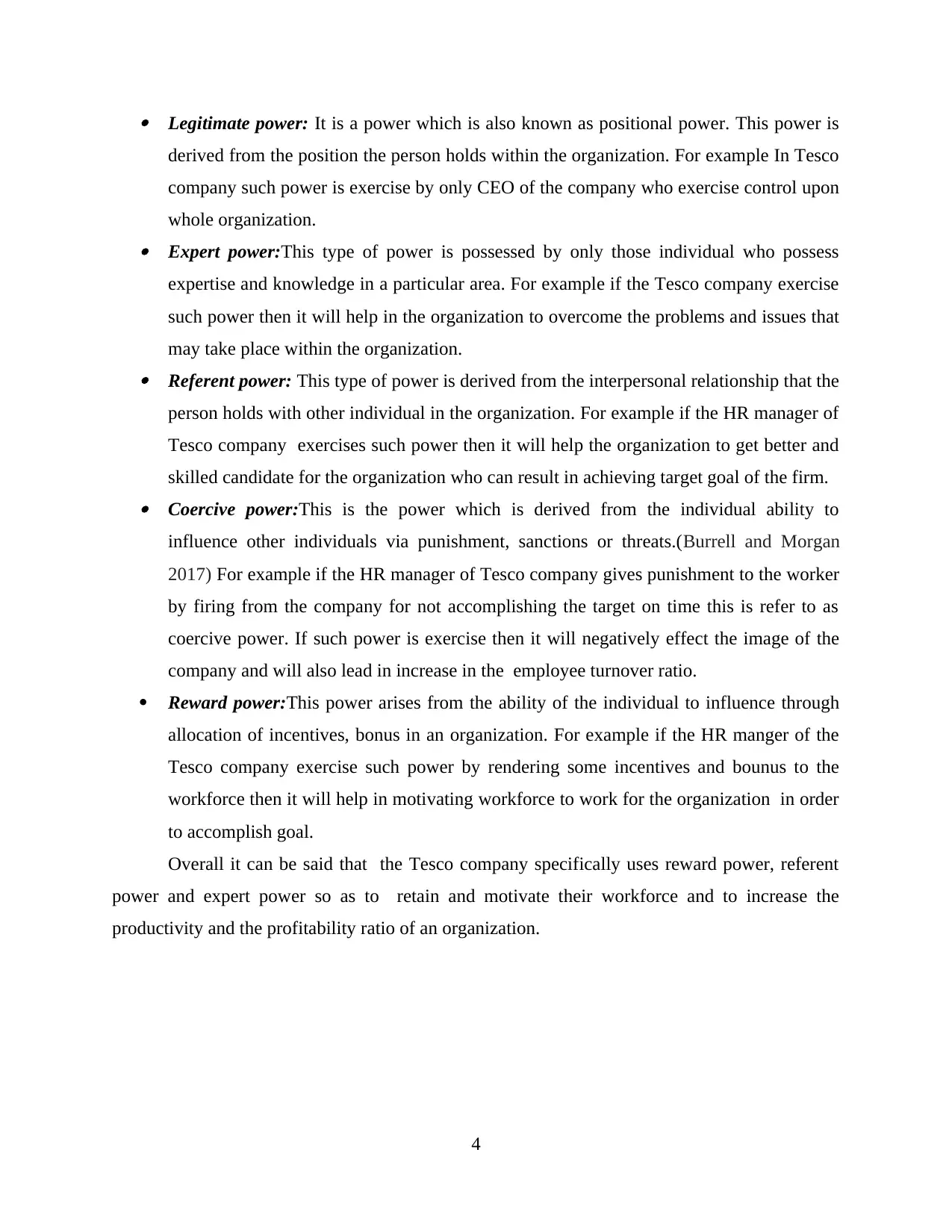
Legitimate power: It is a power which is also known as positional power. This power is
derived from the position the person holds within the organization. For example In Tesco
company such power is exercise by only CEO of the company who exercise control upon
whole organization. Expert power:This type of power is possessed by only those individual who possess
expertise and knowledge in a particular area. For example if the Tesco company exercise
such power then it will help in the organization to overcome the problems and issues that
may take place within the organization. Referent power: This type of power is derived from the interpersonal relationship that the
person holds with other individual in the organization. For example if the HR manager of
Tesco company exercises such power then it will help the organization to get better and
skilled candidate for the organization who can result in achieving target goal of the firm. Coercive power:This is the power which is derived from the individual ability to
influence other individuals via punishment, sanctions or threats.(Burrell and Morgan
2017) For example if the HR manager of Tesco company gives punishment to the worker
by firing from the company for not accomplishing the target on time this is refer to as
coercive power. If such power is exercise then it will negatively effect the image of the
company and will also lead in increase in the employee turnover ratio.
Reward power:This power arises from the ability of the individual to influence through
allocation of incentives, bonus in an organization. For example if the HR manger of the
Tesco company exercise such power by rendering some incentives and bounus to the
workforce then it will help in motivating workforce to work for the organization in order
to accomplish goal.
Overall it can be said that the Tesco company specifically uses reward power, referent
power and expert power so as to retain and motivate their workforce and to increase the
productivity and the profitability ratio of an organization.
4
derived from the position the person holds within the organization. For example In Tesco
company such power is exercise by only CEO of the company who exercise control upon
whole organization. Expert power:This type of power is possessed by only those individual who possess
expertise and knowledge in a particular area. For example if the Tesco company exercise
such power then it will help in the organization to overcome the problems and issues that
may take place within the organization. Referent power: This type of power is derived from the interpersonal relationship that the
person holds with other individual in the organization. For example if the HR manager of
Tesco company exercises such power then it will help the organization to get better and
skilled candidate for the organization who can result in achieving target goal of the firm. Coercive power:This is the power which is derived from the individual ability to
influence other individuals via punishment, sanctions or threats.(Burrell and Morgan
2017) For example if the HR manager of Tesco company gives punishment to the worker
by firing from the company for not accomplishing the target on time this is refer to as
coercive power. If such power is exercise then it will negatively effect the image of the
company and will also lead in increase in the employee turnover ratio.
Reward power:This power arises from the ability of the individual to influence through
allocation of incentives, bonus in an organization. For example if the HR manger of the
Tesco company exercise such power by rendering some incentives and bounus to the
workforce then it will help in motivating workforce to work for the organization in order
to accomplish goal.
Overall it can be said that the Tesco company specifically uses reward power, referent
power and expert power so as to retain and motivate their workforce and to increase the
productivity and the profitability ratio of an organization.
4
⊘ This is a preview!⊘
Do you want full access?
Subscribe today to unlock all pages.

Trusted by 1+ million students worldwide
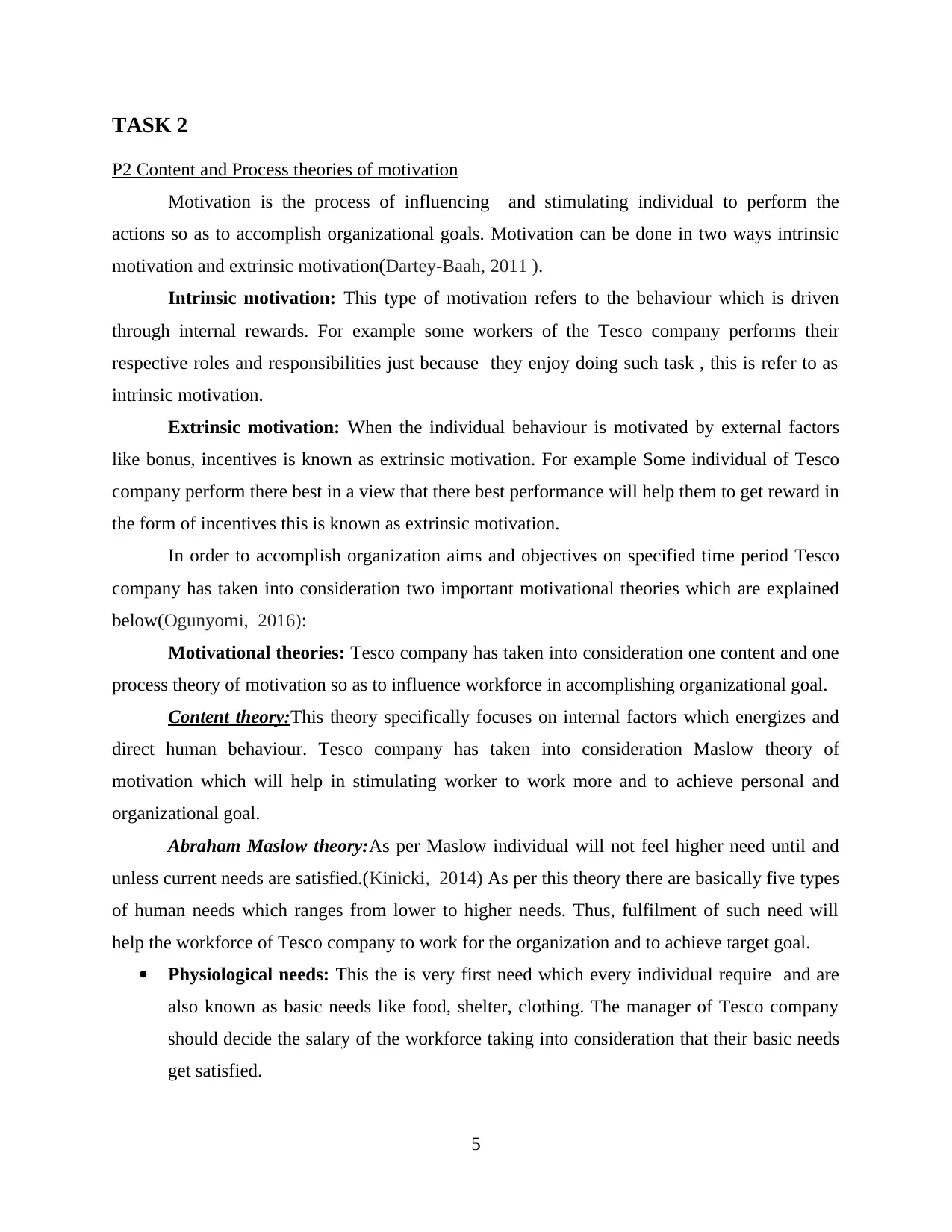
TASK 2
P2 Content and Process theories of motivation
Motivation is the process of influencing and stimulating individual to perform the
actions so as to accomplish organizational goals. Motivation can be done in two ways intrinsic
motivation and extrinsic motivation(Dartey-Baah, 2011 ).
Intrinsic motivation: This type of motivation refers to the behaviour which is driven
through internal rewards. For example some workers of the Tesco company performs their
respective roles and responsibilities just because they enjoy doing such task , this is refer to as
intrinsic motivation.
Extrinsic motivation: When the individual behaviour is motivated by external factors
like bonus, incentives is known as extrinsic motivation. For example Some individual of Tesco
company perform there best in a view that there best performance will help them to get reward in
the form of incentives this is known as extrinsic motivation.
In order to accomplish organization aims and objectives on specified time period Tesco
company has taken into consideration two important motivational theories which are explained
below(Ogunyomi, 2016):
Motivational theories: Tesco company has taken into consideration one content and one
process theory of motivation so as to influence workforce in accomplishing organizational goal.
Content theory:This theory specifically focuses on internal factors which energizes and
direct human behaviour. Tesco company has taken into consideration Maslow theory of
motivation which will help in stimulating worker to work more and to achieve personal and
organizational goal.
Abraham Maslow theory:As per Maslow individual will not feel higher need until and
unless current needs are satisfied.(Kinicki, 2014) As per this theory there are basically five types
of human needs which ranges from lower to higher needs. Thus, fulfilment of such need will
help the workforce of Tesco company to work for the organization and to achieve target goal.
Physiological needs: This the is very first need which every individual require and are
also known as basic needs like food, shelter, clothing. The manager of Tesco company
should decide the salary of the workforce taking into consideration that their basic needs
get satisfied.
5
P2 Content and Process theories of motivation
Motivation is the process of influencing and stimulating individual to perform the
actions so as to accomplish organizational goals. Motivation can be done in two ways intrinsic
motivation and extrinsic motivation(Dartey-Baah, 2011 ).
Intrinsic motivation: This type of motivation refers to the behaviour which is driven
through internal rewards. For example some workers of the Tesco company performs their
respective roles and responsibilities just because they enjoy doing such task , this is refer to as
intrinsic motivation.
Extrinsic motivation: When the individual behaviour is motivated by external factors
like bonus, incentives is known as extrinsic motivation. For example Some individual of Tesco
company perform there best in a view that there best performance will help them to get reward in
the form of incentives this is known as extrinsic motivation.
In order to accomplish organization aims and objectives on specified time period Tesco
company has taken into consideration two important motivational theories which are explained
below(Ogunyomi, 2016):
Motivational theories: Tesco company has taken into consideration one content and one
process theory of motivation so as to influence workforce in accomplishing organizational goal.
Content theory:This theory specifically focuses on internal factors which energizes and
direct human behaviour. Tesco company has taken into consideration Maslow theory of
motivation which will help in stimulating worker to work more and to achieve personal and
organizational goal.
Abraham Maslow theory:As per Maslow individual will not feel higher need until and
unless current needs are satisfied.(Kinicki, 2014) As per this theory there are basically five types
of human needs which ranges from lower to higher needs. Thus, fulfilment of such need will
help the workforce of Tesco company to work for the organization and to achieve target goal.
Physiological needs: This the is very first need which every individual require and are
also known as basic needs like food, shelter, clothing. The manager of Tesco company
should decide the salary of the workforce taking into consideration that their basic needs
get satisfied.
5
Paraphrase This Document
Need a fresh take? Get an instant paraphrase of this document with our AI Paraphraser
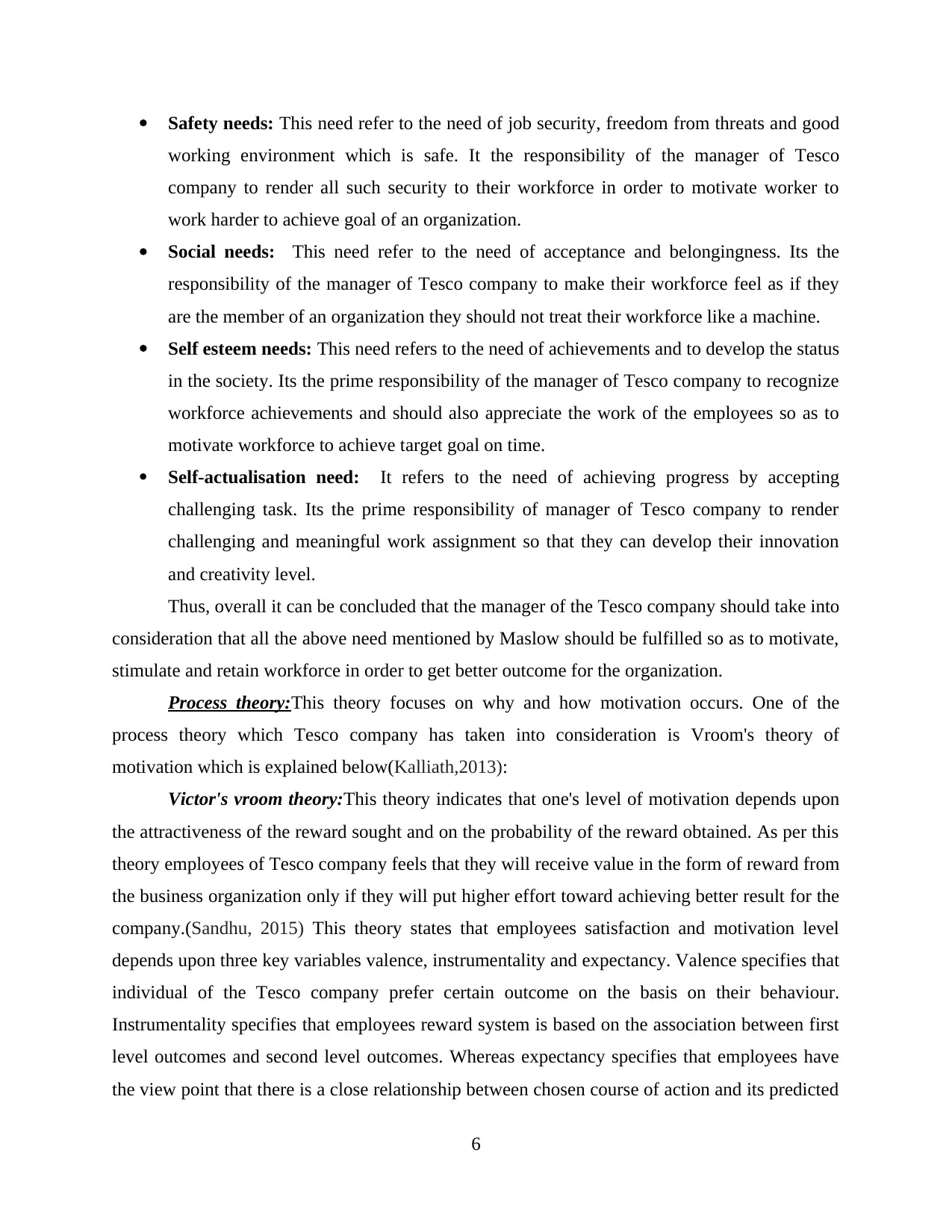
Safety needs: This need refer to the need of job security, freedom from threats and good
working environment which is safe. It the responsibility of the manager of Tesco
company to render all such security to their workforce in order to motivate worker to
work harder to achieve goal of an organization.
Social needs: This need refer to the need of acceptance and belongingness. Its the
responsibility of the manager of Tesco company to make their workforce feel as if they
are the member of an organization they should not treat their workforce like a machine.
Self esteem needs: This need refers to the need of achievements and to develop the status
in the society. Its the prime responsibility of the manager of Tesco company to recognize
workforce achievements and should also appreciate the work of the employees so as to
motivate workforce to achieve target goal on time.
Self-actualisation need: It refers to the need of achieving progress by accepting
challenging task. Its the prime responsibility of manager of Tesco company to render
challenging and meaningful work assignment so that they can develop their innovation
and creativity level.
Thus, overall it can be concluded that the manager of the Tesco company should take into
consideration that all the above need mentioned by Maslow should be fulfilled so as to motivate,
stimulate and retain workforce in order to get better outcome for the organization.
Process theory:This theory focuses on why and how motivation occurs. One of the
process theory which Tesco company has taken into consideration is Vroom's theory of
motivation which is explained below(Kalliath,2013):
Victor's vroom theory:This theory indicates that one's level of motivation depends upon
the attractiveness of the reward sought and on the probability of the reward obtained. As per this
theory employees of Tesco company feels that they will receive value in the form of reward from
the business organization only if they will put higher effort toward achieving better result for the
company.(Sandhu, 2015) This theory states that employees satisfaction and motivation level
depends upon three key variables valence, instrumentality and expectancy. Valence specifies that
individual of the Tesco company prefer certain outcome on the basis on their behaviour.
Instrumentality specifies that employees reward system is based on the association between first
level outcomes and second level outcomes. Whereas expectancy specifies that employees have
the view point that there is a close relationship between chosen course of action and its predicted
6
working environment which is safe. It the responsibility of the manager of Tesco
company to render all such security to their workforce in order to motivate worker to
work harder to achieve goal of an organization.
Social needs: This need refer to the need of acceptance and belongingness. Its the
responsibility of the manager of Tesco company to make their workforce feel as if they
are the member of an organization they should not treat their workforce like a machine.
Self esteem needs: This need refers to the need of achievements and to develop the status
in the society. Its the prime responsibility of the manager of Tesco company to recognize
workforce achievements and should also appreciate the work of the employees so as to
motivate workforce to achieve target goal on time.
Self-actualisation need: It refers to the need of achieving progress by accepting
challenging task. Its the prime responsibility of manager of Tesco company to render
challenging and meaningful work assignment so that they can develop their innovation
and creativity level.
Thus, overall it can be concluded that the manager of the Tesco company should take into
consideration that all the above need mentioned by Maslow should be fulfilled so as to motivate,
stimulate and retain workforce in order to get better outcome for the organization.
Process theory:This theory focuses on why and how motivation occurs. One of the
process theory which Tesco company has taken into consideration is Vroom's theory of
motivation which is explained below(Kalliath,2013):
Victor's vroom theory:This theory indicates that one's level of motivation depends upon
the attractiveness of the reward sought and on the probability of the reward obtained. As per this
theory employees of Tesco company feels that they will receive value in the form of reward from
the business organization only if they will put higher effort toward achieving better result for the
company.(Sandhu, 2015) This theory states that employees satisfaction and motivation level
depends upon three key variables valence, instrumentality and expectancy. Valence specifies that
individual of the Tesco company prefer certain outcome on the basis on their behaviour.
Instrumentality specifies that employees reward system is based on the association between first
level outcomes and second level outcomes. Whereas expectancy specifies that employees have
the view point that there is a close relationship between chosen course of action and its predicted
6
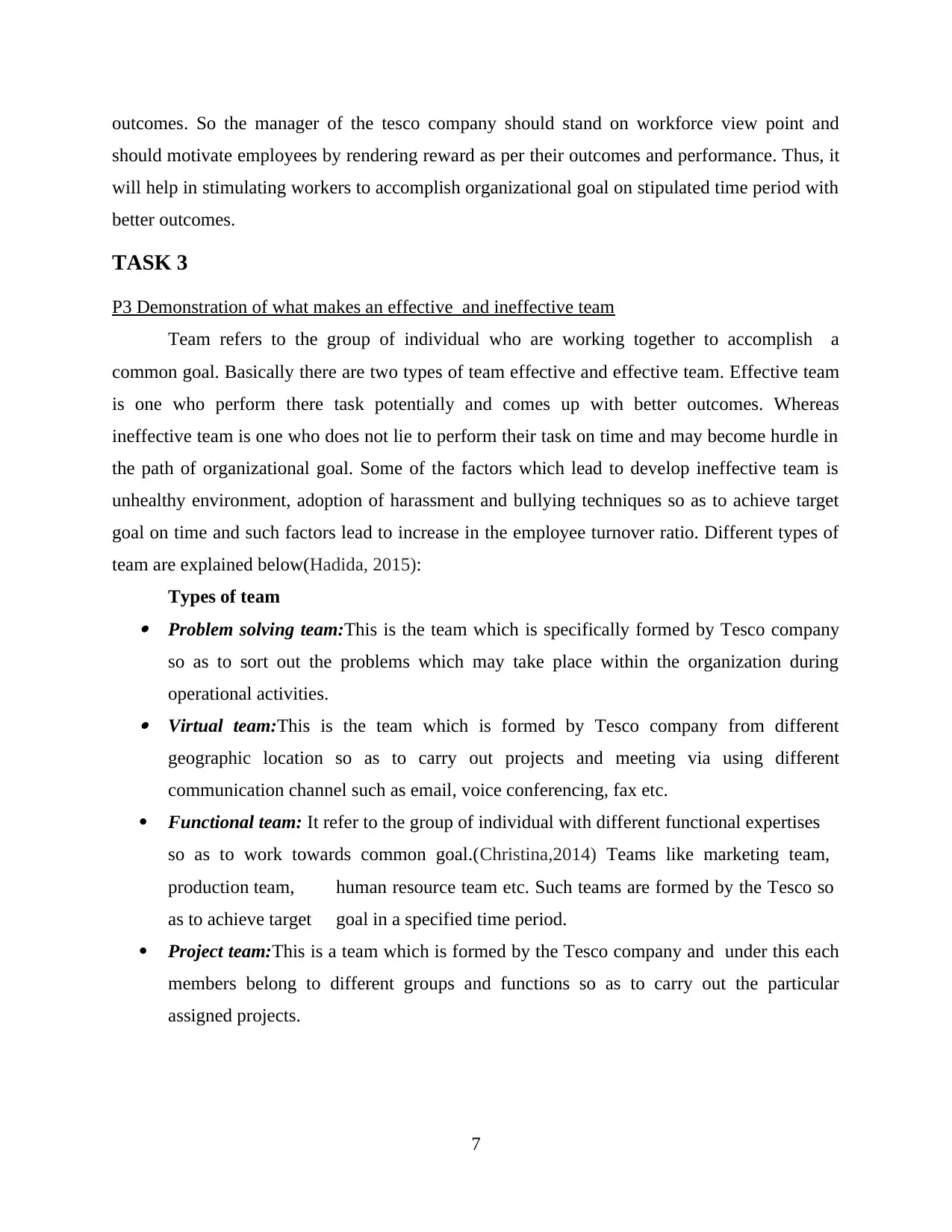
outcomes. So the manager of the tesco company should stand on workforce view point and
should motivate employees by rendering reward as per their outcomes and performance. Thus, it
will help in stimulating workers to accomplish organizational goal on stipulated time period with
better outcomes.
TASK 3
P3 Demonstration of what makes an effective and ineffective team
Team refers to the group of individual who are working together to accomplish a
common goal. Basically there are two types of team effective and effective team. Effective team
is one who perform there task potentially and comes up with better outcomes. Whereas
ineffective team is one who does not lie to perform their task on time and may become hurdle in
the path of organizational goal. Some of the factors which lead to develop ineffective team is
unhealthy environment, adoption of harassment and bullying techniques so as to achieve target
goal on time and such factors lead to increase in the employee turnover ratio. Different types of
team are explained below(Hadida, 2015):
Types of team Problem solving team:This is the team which is specifically formed by Tesco company
so as to sort out the problems which may take place within the organization during
operational activities. Virtual team:This is the team which is formed by Tesco company from different
geographic location so as to carry out projects and meeting via using different
communication channel such as email, voice conferencing, fax etc.
Functional team: It refer to the group of individual with different functional expertises
so as to work towards common goal.(Christina,2014) Teams like marketing team,
production team, human resource team etc. Such teams are formed by the Tesco so
as to achieve target goal in a specified time period.
Project team:This is a team which is formed by the Tesco company and under this each
members belong to different groups and functions so as to carry out the particular
assigned projects.
7
should motivate employees by rendering reward as per their outcomes and performance. Thus, it
will help in stimulating workers to accomplish organizational goal on stipulated time period with
better outcomes.
TASK 3
P3 Demonstration of what makes an effective and ineffective team
Team refers to the group of individual who are working together to accomplish a
common goal. Basically there are two types of team effective and effective team. Effective team
is one who perform there task potentially and comes up with better outcomes. Whereas
ineffective team is one who does not lie to perform their task on time and may become hurdle in
the path of organizational goal. Some of the factors which lead to develop ineffective team is
unhealthy environment, adoption of harassment and bullying techniques so as to achieve target
goal on time and such factors lead to increase in the employee turnover ratio. Different types of
team are explained below(Hadida, 2015):
Types of team Problem solving team:This is the team which is specifically formed by Tesco company
so as to sort out the problems which may take place within the organization during
operational activities. Virtual team:This is the team which is formed by Tesco company from different
geographic location so as to carry out projects and meeting via using different
communication channel such as email, voice conferencing, fax etc.
Functional team: It refer to the group of individual with different functional expertises
so as to work towards common goal.(Christina,2014) Teams like marketing team,
production team, human resource team etc. Such teams are formed by the Tesco so
as to achieve target goal in a specified time period.
Project team:This is a team which is formed by the Tesco company and under this each
members belong to different groups and functions so as to carry out the particular
assigned projects.
7
⊘ This is a preview!⊘
Do you want full access?
Subscribe today to unlock all pages.

Trusted by 1+ million students worldwide
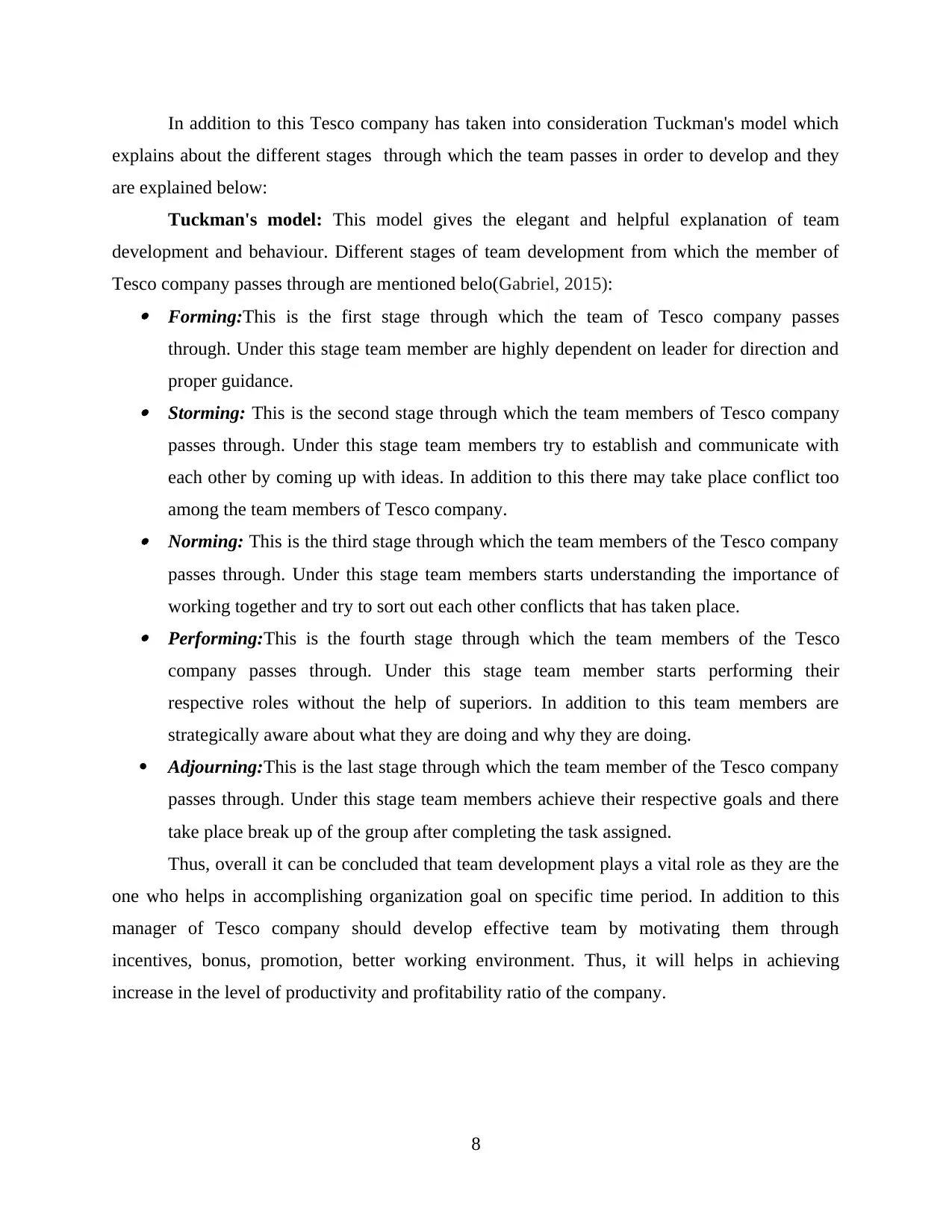
In addition to this Tesco company has taken into consideration Tuckman's model which
explains about the different stages through which the team passes in order to develop and they
are explained below:
Tuckman's model: This model gives the elegant and helpful explanation of team
development and behaviour. Different stages of team development from which the member of
Tesco company passes through are mentioned belo(Gabriel, 2015): Forming:This is the first stage through which the team of Tesco company passes
through. Under this stage team member are highly dependent on leader for direction and
proper guidance. Storming: This is the second stage through which the team members of Tesco company
passes through. Under this stage team members try to establish and communicate with
each other by coming up with ideas. In addition to this there may take place conflict too
among the team members of Tesco company. Norming: This is the third stage through which the team members of the Tesco company
passes through. Under this stage team members starts understanding the importance of
working together and try to sort out each other conflicts that has taken place. Performing:This is the fourth stage through which the team members of the Tesco
company passes through. Under this stage team member starts performing their
respective roles without the help of superiors. In addition to this team members are
strategically aware about what they are doing and why they are doing.
Adjourning:This is the last stage through which the team member of the Tesco company
passes through. Under this stage team members achieve their respective goals and there
take place break up of the group after completing the task assigned.
Thus, overall it can be concluded that team development plays a vital role as they are the
one who helps in accomplishing organization goal on specific time period. In addition to this
manager of Tesco company should develop effective team by motivating them through
incentives, bonus, promotion, better working environment. Thus, it will helps in achieving
increase in the level of productivity and profitability ratio of the company.
8
explains about the different stages through which the team passes in order to develop and they
are explained below:
Tuckman's model: This model gives the elegant and helpful explanation of team
development and behaviour. Different stages of team development from which the member of
Tesco company passes through are mentioned belo(Gabriel, 2015): Forming:This is the first stage through which the team of Tesco company passes
through. Under this stage team member are highly dependent on leader for direction and
proper guidance. Storming: This is the second stage through which the team members of Tesco company
passes through. Under this stage team members try to establish and communicate with
each other by coming up with ideas. In addition to this there may take place conflict too
among the team members of Tesco company. Norming: This is the third stage through which the team members of the Tesco company
passes through. Under this stage team members starts understanding the importance of
working together and try to sort out each other conflicts that has taken place. Performing:This is the fourth stage through which the team members of the Tesco
company passes through. Under this stage team member starts performing their
respective roles without the help of superiors. In addition to this team members are
strategically aware about what they are doing and why they are doing.
Adjourning:This is the last stage through which the team member of the Tesco company
passes through. Under this stage team members achieve their respective goals and there
take place break up of the group after completing the task assigned.
Thus, overall it can be concluded that team development plays a vital role as they are the
one who helps in accomplishing organization goal on specific time period. In addition to this
manager of Tesco company should develop effective team by motivating them through
incentives, bonus, promotion, better working environment. Thus, it will helps in achieving
increase in the level of productivity and profitability ratio of the company.
8
Paraphrase This Document
Need a fresh take? Get an instant paraphrase of this document with our AI Paraphraser
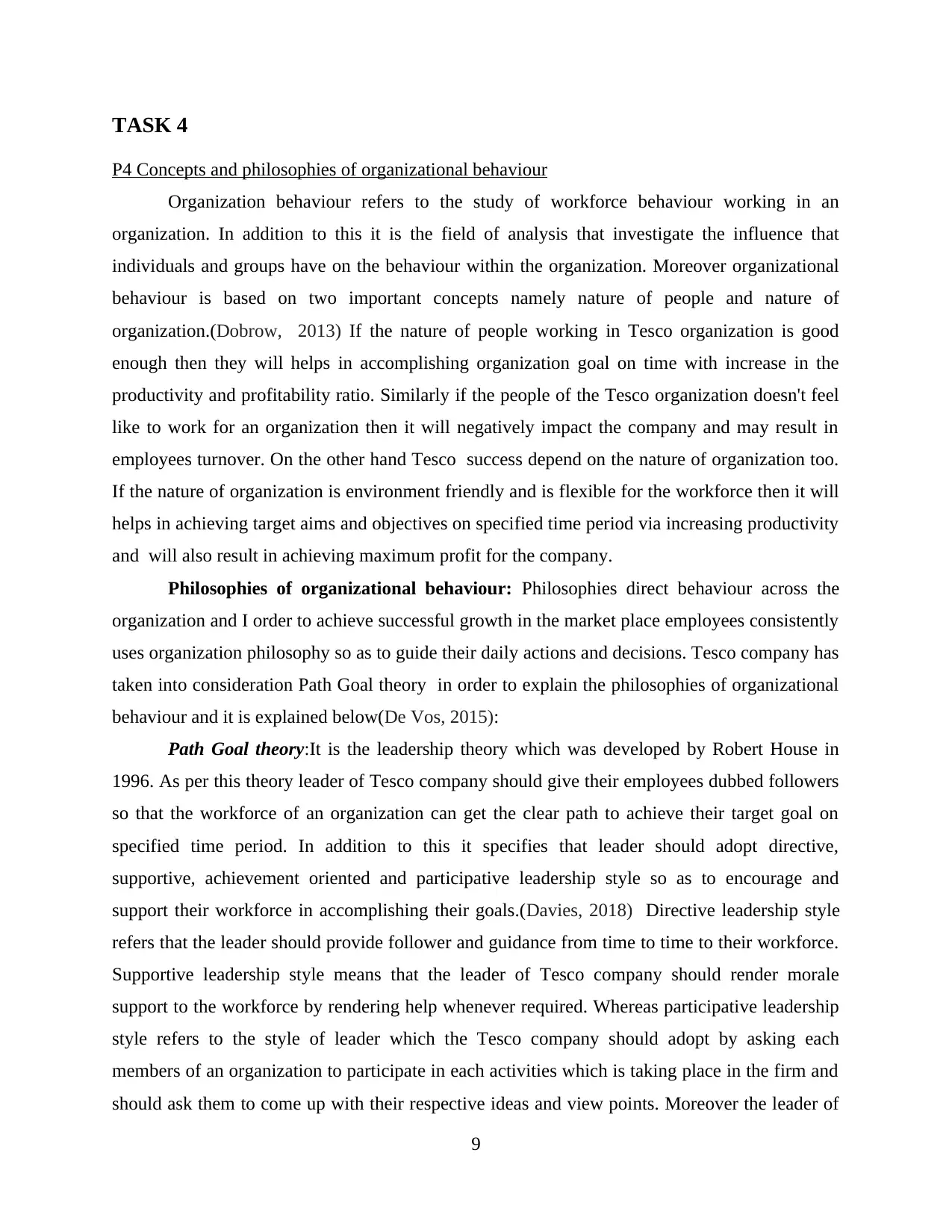
TASK 4
P4 Concepts and philosophies of organizational behaviour
Organization behaviour refers to the study of workforce behaviour working in an
organization. In addition to this it is the field of analysis that investigate the influence that
individuals and groups have on the behaviour within the organization. Moreover organizational
behaviour is based on two important concepts namely nature of people and nature of
organization.(Dobrow, 2013) If the nature of people working in Tesco organization is good
enough then they will helps in accomplishing organization goal on time with increase in the
productivity and profitability ratio. Similarly if the people of the Tesco organization doesn't feel
like to work for an organization then it will negatively impact the company and may result in
employees turnover. On the other hand Tesco success depend on the nature of organization too.
If the nature of organization is environment friendly and is flexible for the workforce then it will
helps in achieving target aims and objectives on specified time period via increasing productivity
and will also result in achieving maximum profit for the company.
Philosophies of organizational behaviour: Philosophies direct behaviour across the
organization and I order to achieve successful growth in the market place employees consistently
uses organization philosophy so as to guide their daily actions and decisions. Tesco company has
taken into consideration Path Goal theory in order to explain the philosophies of organizational
behaviour and it is explained below(De Vos, 2015):
Path Goal theory:It is the leadership theory which was developed by Robert House in
1996. As per this theory leader of Tesco company should give their employees dubbed followers
so that the workforce of an organization can get the clear path to achieve their target goal on
specified time period. In addition to this it specifies that leader should adopt directive,
supportive, achievement oriented and participative leadership style so as to encourage and
support their workforce in accomplishing their goals.(Davies, 2018) Directive leadership style
refers that the leader should provide follower and guidance from time to time to their workforce.
Supportive leadership style means that the leader of Tesco company should render morale
support to the workforce by rendering help whenever required. Whereas participative leadership
style refers to the style of leader which the Tesco company should adopt by asking each
members of an organization to participate in each activities which is taking place in the firm and
should ask them to come up with their respective ideas and view points. Moreover the leader of
9
P4 Concepts and philosophies of organizational behaviour
Organization behaviour refers to the study of workforce behaviour working in an
organization. In addition to this it is the field of analysis that investigate the influence that
individuals and groups have on the behaviour within the organization. Moreover organizational
behaviour is based on two important concepts namely nature of people and nature of
organization.(Dobrow, 2013) If the nature of people working in Tesco organization is good
enough then they will helps in accomplishing organization goal on time with increase in the
productivity and profitability ratio. Similarly if the people of the Tesco organization doesn't feel
like to work for an organization then it will negatively impact the company and may result in
employees turnover. On the other hand Tesco success depend on the nature of organization too.
If the nature of organization is environment friendly and is flexible for the workforce then it will
helps in achieving target aims and objectives on specified time period via increasing productivity
and will also result in achieving maximum profit for the company.
Philosophies of organizational behaviour: Philosophies direct behaviour across the
organization and I order to achieve successful growth in the market place employees consistently
uses organization philosophy so as to guide their daily actions and decisions. Tesco company has
taken into consideration Path Goal theory in order to explain the philosophies of organizational
behaviour and it is explained below(De Vos, 2015):
Path Goal theory:It is the leadership theory which was developed by Robert House in
1996. As per this theory leader of Tesco company should give their employees dubbed followers
so that the workforce of an organization can get the clear path to achieve their target goal on
specified time period. In addition to this it specifies that leader should adopt directive,
supportive, achievement oriented and participative leadership style so as to encourage and
support their workforce in accomplishing their goals.(Davies, 2018) Directive leadership style
refers that the leader should provide follower and guidance from time to time to their workforce.
Supportive leadership style means that the leader of Tesco company should render morale
support to the workforce by rendering help whenever required. Whereas participative leadership
style refers to the style of leader which the Tesco company should adopt by asking each
members of an organization to participate in each activities which is taking place in the firm and
should ask them to come up with their respective ideas and view points. Moreover the leader of
9
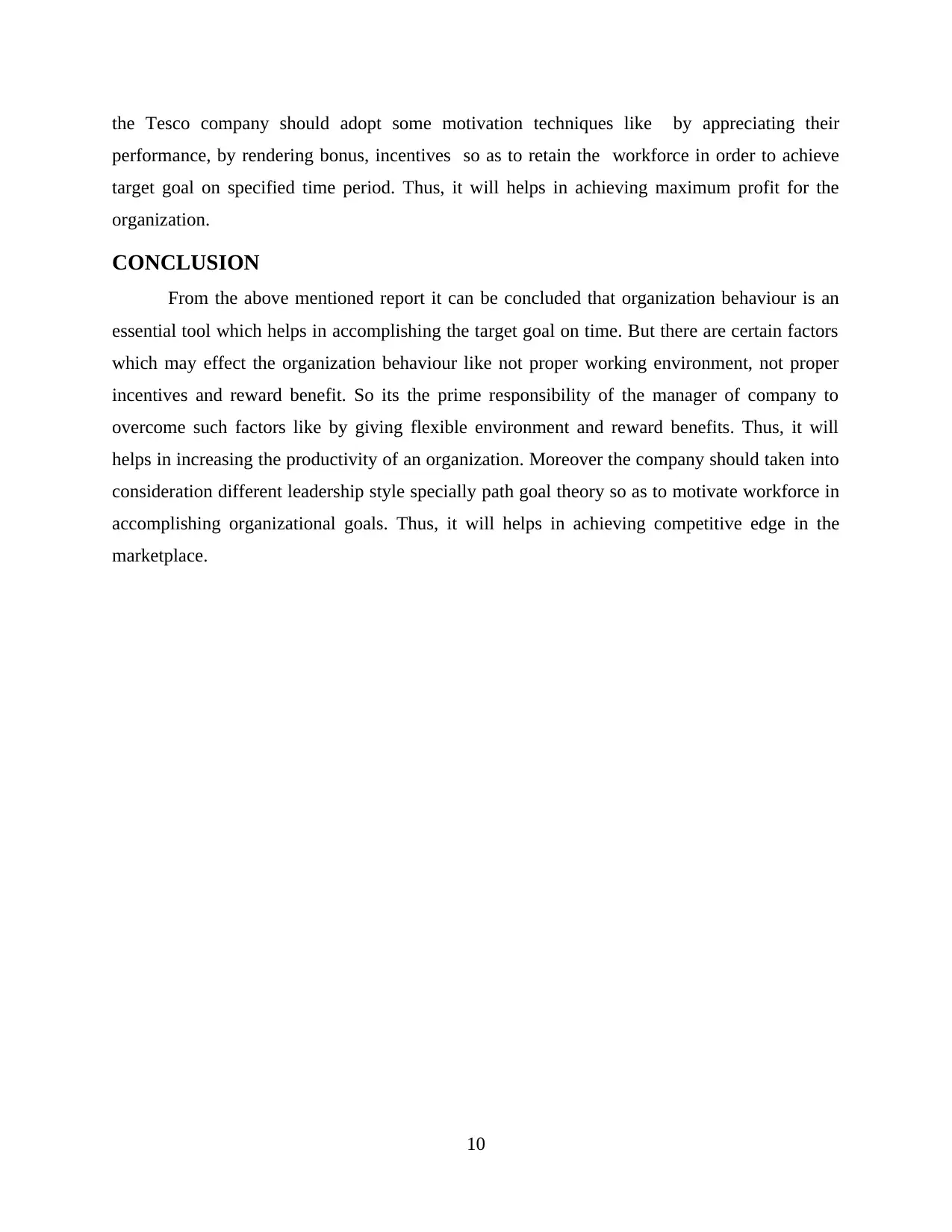
the Tesco company should adopt some motivation techniques like by appreciating their
performance, by rendering bonus, incentives so as to retain the workforce in order to achieve
target goal on specified time period. Thus, it will helps in achieving maximum profit for the
organization.
CONCLUSION
From the above mentioned report it can be concluded that organization behaviour is an
essential tool which helps in accomplishing the target goal on time. But there are certain factors
which may effect the organization behaviour like not proper working environment, not proper
incentives and reward benefit. So its the prime responsibility of the manager of company to
overcome such factors like by giving flexible environment and reward benefits. Thus, it will
helps in increasing the productivity of an organization. Moreover the company should taken into
consideration different leadership style specially path goal theory so as to motivate workforce in
accomplishing organizational goals. Thus, it will helps in achieving competitive edge in the
marketplace.
10
performance, by rendering bonus, incentives so as to retain the workforce in order to achieve
target goal on specified time period. Thus, it will helps in achieving maximum profit for the
organization.
CONCLUSION
From the above mentioned report it can be concluded that organization behaviour is an
essential tool which helps in accomplishing the target goal on time. But there are certain factors
which may effect the organization behaviour like not proper working environment, not proper
incentives and reward benefit. So its the prime responsibility of the manager of company to
overcome such factors like by giving flexible environment and reward benefits. Thus, it will
helps in increasing the productivity of an organization. Moreover the company should taken into
consideration different leadership style specially path goal theory so as to motivate workforce in
accomplishing organizational goals. Thus, it will helps in achieving competitive edge in the
marketplace.
10
⊘ This is a preview!⊘
Do you want full access?
Subscribe today to unlock all pages.

Trusted by 1+ million students worldwide
1 out of 15
Related Documents
Your All-in-One AI-Powered Toolkit for Academic Success.
+13062052269
info@desklib.com
Available 24*7 on WhatsApp / Email
![[object Object]](/_next/static/media/star-bottom.7253800d.svg)
Unlock your academic potential
Copyright © 2020–2025 A2Z Services. All Rights Reserved. Developed and managed by ZUCOL.





